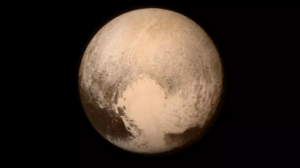While scouring images taken by NASA’s New Horizons spacecraft of Pluto’s surface, a team of astronomers made a tantalizing discovery.
“We found a field of very large icy volcanoes that look nothing like anything else we have seen in the solar system,” Kelsi Singer, senior research scientist at the Southwest Research Institute in Boulder, Colorado, and author of a new study published in the journal Nature Communications, told CNN.
The finding goes to show the tiny planet still has plenty of surprises in store for us — and could be more habitable for life previously believed, the researchers say.
The area covers 621 miles across an ancient impact basin. Two of its largest volcanic domes are roughly the size of Earth-based volcanos, including Mauna Loa in Hawaii, our world’s biggest volcano by volume.
Since the area itself doesn’t have any new impact craters, the researchers suggest the massive ice volcanoes aren’t actually that old and were formed as a result of residual heat emanating from the tiny planet’s interior.
“This means Pluto has more internal heat than we thought it would, which means we don’t fully understand how planetary bodies work,” Singer told CNN.
Rather than spectacularly erupting in an explosion of magma, these ice volcanoes vent a slurry of ice and water kind “like toothpaste,” she explained.
Putin threatens to cut off gas supplies to Europe if they do not pay in Rubles
It’s an intriguing discovery that adds to existing theories about what scientists believe to be Pluto’s sizeable subsurface ocean. The volcanoes could be evidence that liquid water is closer to the surface than previously thought.
That could also influence the planet’s ability to harbor life — but it’s still a bit of a stretch.
“There are still a lot of challenges for any organisms trying to survive there,” Singer told CNN. “They would still need some source of continual nutrients, and if the volcanism is episodic and thus the heat and water availability is variable, that is sometimes tough for organisms as well.”
The team is now excited to send a spacecraft outfitted with a radar to examine “what the volcanic plumbing looks like,” as Singer put it.
Source: Futurism
Ask me anything
Explore related questions





